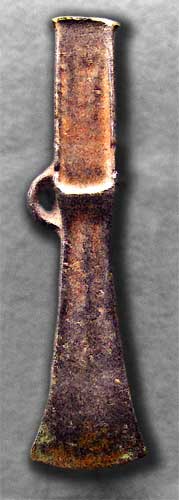
Palstave
Encyclopedia

Bronze
Bronze is a metal alloy consisting primarily of copper, usually with tin as the main additive. It is hard and brittle, and it was particularly significant in antiquity, so much so that the Bronze Age was named after the metal...
axe
Axe
The axe, or ax, is an implement that has been used for millennia to shape, split and cut wood; to harvest timber; as a weapon; and as a ceremonial or heraldic symbol...
. It was common in the mid Bronze Age
Bronze Age
The Bronze Age is a period characterized by the use of copper and its alloy bronze as the chief hard materials in the manufacture of some implements and weapons. Chronologically, it stands between the Stone Age and Iron Age...
in north, western and south-western Europe. In the technical sense, although precise definitions differ, an axe is generally deemed to be a palstave if it is hafted by means of a forked wooden handle kept in place with high, cast flanges and stop bar. The axe should be much thicker on the blade side of the stop bar than the hafting side (Schmidt and Burgess 1981, 115). In these respects it is very close, but distinct from, earlier 'flanged axes'.
The archaeologist John Evans
John Evans (archaeologist)
Sir John Evans, KCB, FRS was an English archaeologist and geologist.-Biography:John Evans was the son of the Rev. Dr A. B. Evans, headmaster of Market Bosworth Grammar School, and was born at Britwell Court, Buckinghamshire...
(1881, 72) popularized the term 'palstave' in English
English language
English is a West Germanic language that arose in the Anglo-Saxon kingdoms of England and spread into what was to become south-east Scotland under the influence of the Anglian medieval kingdom of Northumbria...
following Danish
Denmark
Denmark is a Scandinavian country in Northern Europe. The countries of Denmark and Greenland, as well as the Faroe Islands, constitute the Kingdom of Denmark . It is the southernmost of the Nordic countries, southwest of Sweden and south of Norway, and bordered to the south by Germany. Denmark...
archaeologists who borrowed the term from . Confusingly, a paalstab is not an axe, but a digging tool. However, the term had become so common with Scandinavia
Scandinavia
Scandinavia is a cultural, historical and ethno-linguistic region in northern Europe that includes the three kingdoms of Denmark, Norway and Sweden, characterized by their common ethno-cultural heritage and language. Modern Norway and Sweden proper are situated on the Scandinavian Peninsula,...
n and German
Germany
Germany , officially the Federal Republic of Germany , is a federal parliamentary republic in Europe. The country consists of 16 states while the capital and largest city is Berlin. Germany covers an area of 357,021 km2 and has a largely temperate seasonal climate...
archaeologists that Evans thought it best to follow suit.

